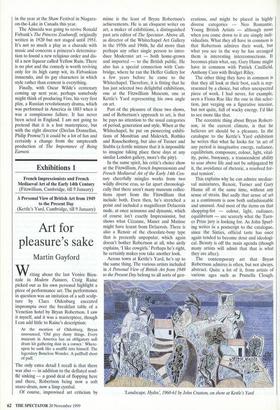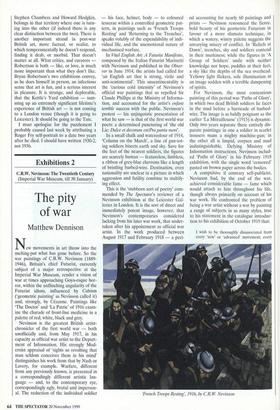Exhibitions 1
French Impressionists and French Mediaeval Art of the Early 14th Century (Fitzwilliam, Cambridge, till 9 January) A Personal View of British Art from 1949 to the Present Day (Kettle's Yard, Cambridge, till 9 January)
Art for pleasure's sake
Martin Gayford
Writing about the last Venice Bien- nale in Modern Painters, Craig Raine picked out as his own personal highlight a piece of performance art. The performance in question was an imitation of a soft sculp- ture by Claes Oldenburg executed impromptu over the breakfast table of a Venetian hotel by Bryan Robertson. I saw it myself, and it was a masterpiece, though I can add little to Raine's description:
At the mention of Oldenburg, Bryan announced, 'Old grey dusty things. Every museum in America has an obligatory soft drum kit gathering dust in a corner.' Where- upon he sank like a soufflé into himself. The legendary Boneless Wonder. A puffball short of puff.
The only extra detail I recall is that there was also — in addition to the deflated souf- fle sinking — a good deal of flopping here and there, Robertson being now a soft snare-drum, now a limp cymbal.
Of course, improvised art criticism by mime is the least of Bryan Robertson's achievements. He is an eloquent writer on art, a maker of exhibitions, a distinguished past arts editor of The Spectator. Above all, as director of the Whitechapel Art Gallery in the 1950s and 1960s, he did more than perhaps any other single person to intro- duce Modernist art — both home-grown and imported — to the British public. He also has a special connection with Cam- bridge, where he ran the Hefter Gallery for a few years before he came to the Whitechapel. Therefore, it is fitting that he has just selected two delightful exhibitions, one at the Fitzwilliam Museum, one at Kettle's Yard representing his own angle on art.
Part of the pleasure of these two shows, and of Robertson's approach to art, is that he pays no attention to the usual categories of period, generation and style. When at the Whitechapel, he put on pioneering exhibi- tions of Mondrian and Malevich, Rothko and Rauschenberg, but also of Turner and Stubbs (a fertile mixture that it is impossible to imagine taking place these days at any similar London gallery, more's the pity).
In the same spirit, his critic's choice show at the Fitzwilliam, French Impressionists and French Mediaeval Art of the Early 14th Cen- tury cheerfully mingles works from two wildly diverse eras, so far apart chronologi- cally that there aren't many museum collec- tions apart from the Fitzwilliam that include both. Even then, he's stretched a point and included a magnificent Delacroix nude, at once sensuous and dynamic, which of course isn't exactly Impressionist, but shows what Cezanne, Manet and Matisse might have learnt from Delacroix. There is also a Renoir of the chocolate-boxy type that is presently unpopular, which again doesn't bother Robertson at all, who airily explains, 'I like cowgirls.' Perhaps he's right, he certainly makes you take another look.
Across town at Kettle's Yard, he's up to the same thing. The various artists included in A Personal View of British Art from 1949 to the Present Day belong to all sorts of gcn-
erations, and might be placed in highly diverse categories — Neo Romantic, Young British Artists — although most when you come down to it are simply indi- vidualists. What they all have in common is that Robertson admires their work, but what you see in the way he has arranged them is interesting interconnections. It becomes plain what, say, Gary Hume might have in common with Patrick Caulfield, Anthony Caro with Bridget Riley.
The other thing they have in common is that they all look at their best, each is rep- resented by a choice, but often unexpected piece of work. I had never, for example, seen a Fiona Rae like the one in this selec- tion, just verging on a figurative interior, but not quite, full of wacky energy. I'd like to see more like that.
The eccentric thing about Bryan Robert- son, in the current climate, is that he believes art should be a pleasure. In the catalogue to the Kettle's Yard exhibition he writes that what he looks for 'in art of any period is imaginative energy, radiance, equilibrium, composure, colour, light, vital- ity, poise, buoyancy, a transcendent ability to soar above life and not be subjugated by it, the avoidance of rhetoric, a resolved for- mal tension'.
This explains why he can admire mediae- val miniatures, Renoir, Turner and Gary Hume all at the same time, without any sense of strain. But sadly that sense of art as a continuum is now both unfashionable and unusual. And most of the items on that shopping-list — colour, light, radiance, equilibrium — are scarcely what the Turn- er Prize jury is looking for. As John Spurt- ing writes in a postscript to the catalogue, since the Sixties, official taste has once again tended to become dour and ideologi- cal. Beauty is off the main agenda (though many artists will admit that that is what they are after).
The contemporary art that Bryan Robertson admires is often, but not always, abstract. Quite a lot of it, from artists of various ages such as Prunella Clough, 'Landscape, Hydra' 1960-61 by John Craxton, on show at Kettle's Yard Stephen Chambers and Howard Hodgkin, belongs in that territory where one is turn- ing into the other (if indeed there is any clear distinction between the two). There is another important strand in post-war British art, more factual, or realist, to which temperamentally he doesn't respond, finding it drab, or morbid. That doesn't matter at all. What critics, and curators Robertson is both — like, or love, is much more important than what they don't like. Bryan Robertson's two exhibitions convey, as he does himself in person, an infectious sense that art is fun, and a serious interest in pleasure. It is strange, and deplorable, that the Kettle's Yard exhibition — sum- ming up an extremely significant lifetime's experience of British art — is not coming to a London venue (though it is going to Leicester). It should be going to the Tate.
I must apologise for the puzzlement I probably caused last week by attributing a Roger Fry self-portrait to a date two years after he died. I should have written 1930-2, not 1936.



























































































 Previous page
Previous page